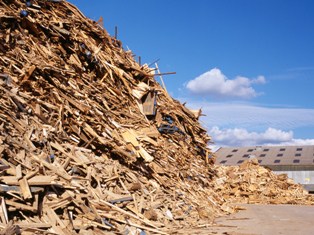The Environment Agency has “revised and updated” its fire prevention plans (FPP) guidance for waste sites, providing case study examples of alternative measures proposed by operators.
First released in July 2016 (see letsrecycle.com story), the FPP guidance update looks at topics including previous rules restricting storage and separation distances between piles of waste materials.
Under the terms of the revisions, operators are able to offer “alternative measures” to those proposed – provided they still meet three main objectives of: minimising the likelihood of a fire happening; aiming for a fire to be extinguished within four hours; and, minimising the spread of fire within the site and to neighbouring sites.
Testing
One example provided by the Environment Agency was an operator who wanted to store pre-crushed wood for 120 days, which was for longer than the permitted three months.
Due to concerns over mass self-heating the operator had carried out a sieve test on a sample of the material. The results showed that more than 10% of the sample contained fraction sizes of less than 100mm.
Because the smaller fraction size can promote self-heating the operator sent a wood sample basket testing, which showed the time to ignition was 200 days.
“As the operator proposed to store the wood for no longer than 120 days this provided reassurance that mass self-heating would not occur within that time frame,” the Agency said.
Stack heights
The guidance sets a limit of four metres for stack heights, which has proved problematic for some recyclers.
In one example given by the EA, a waste wood operator wanted to store pre-crushed wood in pile sizes larger than the maximum sizes set out.
While all plans are site specific, the EA says in this example, the operator put forward a number of measures to mitigate fire risks. This included early detection using a thermal imaging system that would alert nominated staff by text, 24/7.
Staff would be available 24/7 to use diggers and loading shovels to reduce the stack sizes to make sure a fire could be extinguished within four hours.
‘The operator provided a timed demonstration, including travel time taken for staff to arrive on site’
The EA says the operator provided a timed demonstration, including travel time taken for staff to arrive on site.
The operator also took other steps to mitigate risks such as parking vehicles away from the stacks when not in use and washing them down at the end of each shift, and ensuring sites are manned 24/7 to reduce the potential for arson.
The security guard used a hand-held thermal imaging camera and would monitor the piles for an increase in temperature. If they detected the trigger temperature of 50°C, they would alert the site operator and staff would come to the site. Staff would help with active firefighting by moving stacks and creating firebreaks.
This emergency plan had been tested with the local Fire and Rescue Service present and “we considered it to be effective”, the Agency remarked.
EfW
Further examples provided by the Environment Agency included an operator of an energy from waste plant who wanted to store municipal waste for two weeks in higher storage piles than usually allowed.

An EfW operator was able to prove that measures, such as constantly moving the waste, reduced the fire risk from higher storage piles
The Agency said the operator was able to prove that the bunkered storage area was monitored by an accredited thermal imaging system linked to a series of water cannons. The control room of the facility was staffed 24/7.
Also, an overhead grab constantly moved the waste within the bunker to create a more homogenised material to improve the incineration process. As the waste was being constantly moved the risk of mass self-heating was reduced. The thermal imaging system was likely to detect any heating event.
“This all reassured us that fires could be extinguished within the four hour window,” the Agency added.
Other examples provided by the EA include some for metal recycling operations and also for some who wanted to reduce the gap in between stacks.
Guide
The Agency has always said it intends to be flexible with the guidance, with alternative measures accepted providing they still meet the targets set out in the guidance, but this is thought to be the first example of specific measures.
Useful links
Fire prevention plans: case study examples of alternative measures
The post ‘Alternative measures’ cited for fire prevention appeared first on letsrecycle.com.
Source: letsrecycle.com Waste Managment



